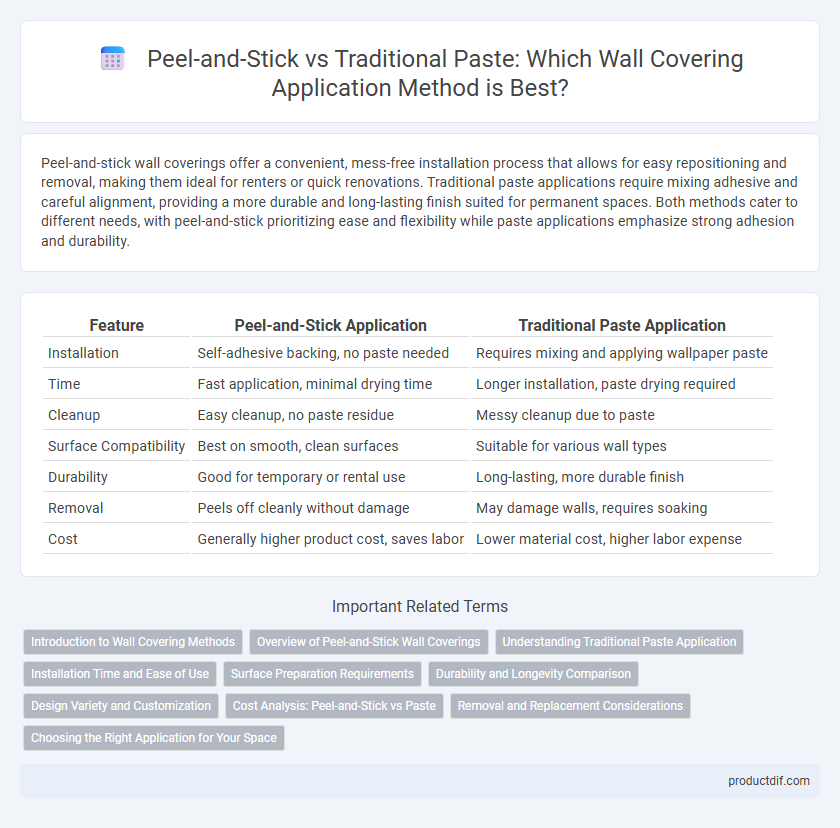Peel-and-stick wall coverings offer a convenient, mess-free installation process that allows for easy repositioning and removal, making them ideal for renters or quick renovations. Traditional paste applications require mixing adhesive and careful alignment, providing a more durable and long-lasting finish suited for permanent spaces. Both methods cater to different needs, with peel-and-stick prioritizing ease and flexibility while paste applications emphasize strong adhesion and durability.
Table of Comparison
| Feature | Peel-and-Stick Application | Traditional Paste Application |
|---|---|---|
| Installation | Self-adhesive backing, no paste needed | Requires mixing and applying wallpaper paste |
| Time | Fast application, minimal drying time | Longer installation, paste drying required |
| Cleanup | Easy cleanup, no paste residue | Messy cleanup due to paste |
| Surface Compatibility | Best on smooth, clean surfaces | Suitable for various wall types |
| Durability | Good for temporary or rental use | Long-lasting, more durable finish |
| Removal | Peels off cleanly without damage | May damage walls, requires soaking |
| Cost | Generally higher product cost, saves labor | Lower material cost, higher labor expense |
Introduction to Wall Covering Methods
Peel-and-stick wall coverings offer a modern, mess-free alternative to traditional paste application by using an adhesive backing that simplifies installation and removal processes. Traditional paste application requires preparing the wall, mixing paste, and applying it carefully to ensure proper adhesion and durability of wallpaper. Both methods cater to different preferences and project requirements, with peel-and-stick favored for quick updates and paste application suited for long-term, professional-quality finishes.
Overview of Peel-and-Stick Wall Coverings
Peel-and-stick wall coverings offer a mess-free, adhesive-backed alternative to traditional paste applications, simplifying installation and reducing preparation time. These self-adhesive panels are designed for easy repositioning, making them ideal for DIY projects and temporary decor updates. Their moisture resistance and durability provide both aesthetic appeal and practical benefits compared to conventional paste-applied wallpapers.
Understanding Traditional Paste Application
Traditional paste application for wall covering involves manually applying adhesive paste to either the wallpaper backing or directly onto the wall surface, ensuring strong adhesion and durability. This method requires careful preparation of the walls, including cleaning and priming, to prevent peeling and bubbling over time. Experienced installers often prefer traditional paste application for complex patterns and textured wallpapers, as it allows precise adjustment during hanging.
Installation Time and Ease of Use
Peel-and-stick wall coverings significantly reduce installation time by eliminating the need for messy paste preparation and drying, allowing for immediate adhesion to surfaces. Their user-friendly design simplifies alignment and repositioning during application, making them ideal for DIY projects and quick renovations. Traditional paste application requires mixing adhesive, precise brushing, and waiting for the paste to become tacky, which increases installation complexity and duration.
Surface Preparation Requirements
Peel-and-stick wallpaper requires minimal surface preparation, needing a clean, smooth, and dry wall for optimal adhesion, making it ideal for quick renovations. Traditional paste application demands thorough surface treatment including priming, smoothing imperfections, and sometimes sealing to ensure proper paste bonding and avoid peeling. Proper surface preparation directly influences longevity and appearance, with peel-and-stick offering a more user-friendly approach for less porous and well-maintained walls.
Durability and Longevity Comparison
Peel-and-stick wall coverings offer a convenient installation but generally lack the long-term durability of traditional paste-applied wallpapers, which create a stronger adhesive bond with the wall surface. Traditional paste application ensures greater resistance to moisture, peeling, and wear over time, often extending the wallpaper's lifespan beyond a decade with proper maintenance. Durability and longevity are critical factors in wall covering selection, where paste-applied options typically outperform peel-and-stick variants in maintaining appearance and adhesion in high-traffic or humid environments.
Design Variety and Customization
Peel-and-stick wall coverings offer extensive design variety with easy customization, allowing homeowners to experiment with patterns and textures without the mess of traditional paste application. This adhesive method supports rapid installation and removal, encouraging frequent design updates tailored to evolving tastes and seasonal decor changes. Traditional paste application, while durable, limits spontaneous customization due to its messiness and longer drying time, making peel-and-stick options ideal for dynamic, design-focused environments.
Cost Analysis: Peel-and-Stick vs Paste
Peel-and-stick wall coverings generally incur higher upfront material costs compared to traditional paste applications but save significantly on labor expenses due to their simple, mess-free installation process. Traditional paste applications demand additional costs for adhesives, tools, and skilled labor, which can increase overall project expenses despite lower material prices. For budget-conscious projects, peel-and-stick offers cost efficiency by reducing installation time and cleanup, whereas paste application may be more economical for large-scale jobs with available skilled labor.
Removal and Replacement Considerations
Peel-and-stick wall coverings offer easy removal without damaging the wall surface, making replacement quick and hassle-free, ideal for renters or frequent redecorators. Traditional paste applications often require soaking and scraping, which can damage drywall or paint and extend repair time after removal. Choosing peel-and-stick solutions reduces downtime and labor costs associated with wall preparation and cleanup during replacement.
Choosing the Right Application for Your Space
Peel-and-stick wall coverings offer quick installation with minimal mess, making them ideal for renters and temporary spaces, while traditional paste application provides superior durability and a seamless finish suited for long-term use. Selecting the right method depends on factors such as room humidity, surface texture, and expected lifespan of the decoration. For high-moisture areas like bathrooms, paste applications often ensure better adhesion, whereas peel-and-stick options excel in low-traffic or decorative accent walls.
Peel-and-Stick Application vs Traditional Paste Application Infographic

 productdif.com
productdif.com